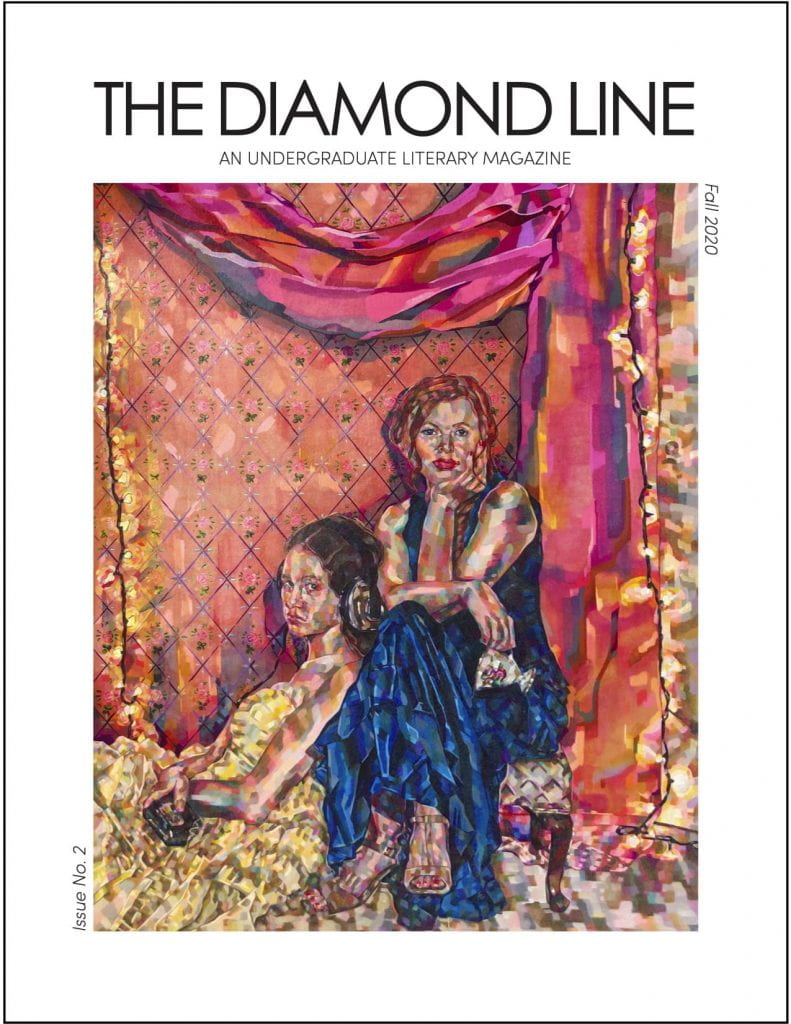The first two issues of the new undergraduate literary magazine, The Diamond Line, were released in 2020. Developed by students enrolled in the department’s Literary Magazine Production course, The Diamond Line features fiction, poetry, and visual art submitted by undergraduate students at the University of Arkansas. In the interview, below, we talk with Jane Blunschi, Assistant Director of the Program in Creative Writing and Translation, who teaches the Literary Magazine Production course.
How did you originally come up with the idea for The Diamond Line?
I didn’t do it alone! The idea for the class came from a few different sources. In 2019, a group of undergraduate creative writers visited my office to ask if I’d sponsor a club to produce a literary magazine. They knew that one had existed on campus previously and were eager to revive it. I was excited about the idea from the beginning, and wanted to find a way to make it a more enduring publication, one that wouldn’t disappear when a group of editors graduated without new editors to take the lead. Davis McCombs, Director of the Program in Creative Writing and Translation, suggested I design a section of ENGL 3903 (Special Topics) to produce the magazine regularly. The inaugural issue of The Diamond Line was the product of the first section of that class.
So, the publication of each issue corresponds with a semester-long course, Literary Magazine Production, that you teach to undergraduate students. Could you talk a little about how you instruct students coming into your course–and collaborate with them–on putting together each issue? Are there mostly English undergraduates in the class, or do students from other majors also tend to enroll? When is the next issue coming out?
The students in Literary Magazine Production work through every stage of publication. I send out a call for submissions at the beginning of the semester, and the class gets to work on research of other undergraduate literary magazines. They present their findings, and we discuss the ways those other publications have handled content and design, and what inspiration for TDL could be drawn from them. When the deadline for submissions closes, the class works in editorial teams to bring the strongest pieces of poetry, prose, and visual art to a whole-class workshop. Once decisions about content have been made, design production begins, with teams of students working on print and website design, as well as strategies to promote the magazine.
The class has mostly been composed of English majors so far, with quite a few Creative Writing concentrators. I strongly encourage any student who needs a 3000-level English elective to join the class, though. It provides students with opportunities to practice problem-solving and work in a sustained mode of collaboration, and calls upon members of the class to consistently employ their creative, technical, and editorial skills. A new issue is produced each semester, and Issue 3 is set for release in mid-May, 2021.
Needless to say, students in your course are being encouraged to apply their academic skills in a unique way–instead of developing and being graded on traditional essay documents, they are collaborating on the production and promotion of a real magazine that’s shared with the public. To what extent do you and your students discuss the experience of professionalization your class is offering them? Are many of them planning to continue working in some area of publishing in the future?
Quite a few students who’ve taken the class have expressed an interest in a career in publishing, and they have an opportunity to work in a variety of editorial roles in the process of producing an issue of The Diamond Line. The class also gives creative writers who are preparing and submitting their work for publication a glimpse into the process of choosing pieces to include in a literary magazine. I hope that it serves to de-mystify the process and empowers them to continue pursuing their goals in publication.
I’m just wondering if you, as an author as well as a member of the Creative Writing faculty with our department, had a similar experience in your own undergraduate program. Put another way: who, or what course, most inspired you while you were pursuing your bachelor’s degree to become a professional writer (author of Love, Tupelo and Understand Me, Sugar).
I didn’t take a class like this as an undergraduate, but I will say that the classes that inspired me most at that time were taught by professors who encouraged me to keep writing and believing in my work. The class that stands out as one of my strongest influences and inspirations was a humanities course about magical realism. We read the work of Gabriel García Márquez, Isaac Bashevis Singer, and Marc Chagall. (I recommend his autobiography, My Life!) We also studied Chagall’s paintings, along with the work of Frida Kahlo and Antoni Gaudí. Discovering connections between these seemingly disparate works truly influenced the way I began to see the world around me and communicate, especially in my writing. It was really cool.



